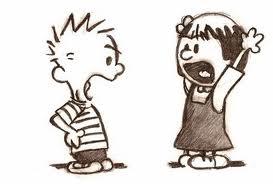Tension on Every Page, Part II
In Part I, we talked about the importance of including conflict and tension of some sort on every page of your novel. Why? Because in fiction, “the best times for the writer – and reader – are when the story’s main character is in the worst trouble. Let your character relax, feel happy and content, and be worried about nothing, and your story dies.” (Jack M. Bickham)

Referring to Alfred Hitchcock’s well-known quote about effective film-making, “Drama is life with the dull parts left out,” James Scott Bell says, “You don’t want dull parts in your fiction, and dull parts are those without trouble. The greater the trouble, the greater the intensity.”
Bell goes on to advise us, “You want to have some sort of tension in every scene, though it doesn’t have to be of the highest sort. That would wear out the reader. Modulating tension is one of the keys to writing fiction. You give your readers some breathing room, too. But when they breathe, let it be with a tight chest.”
And as we said in Part I, you need to include tension right from in your opening paragraph, in order to hook your readers in. Donald Maass says, “Bridging conflict carries the reader from the opening line to the moment when the central conflict is set.” Then you’ll need to continue to include tension and conflict, whether external (arguments, fights, verbal sparring, threats) or internal (worry, anger, hurt, indecision, fear, angst, frustration, regret) on every page of your novel.
What are some techniques for achieving this? Here are some practical tips from writing gurus for revising your WIP to add more tension and spice up the scenes.
Create conflict between two people, not just accidents
Jack Bickham insists that effective tension in fiction involves conflict between two people, not just random accidents and bad luck for your protagonist. Give your hero or heroine something they can fight against, to challenge them and help them grow and develop their character and inner strength.

Conflict, according to Bickham, is “active give-and-take, a struggle between story people with opposing goals. It is not, please note, bad luck or adversity. It isn’t fate. It’s a fight of some kind between people with opposing goals.”
Why not just have your character get into an accident? That works well once in a while to throw a wrench in the works, but, as Bickham says, “Adversity in all its forms may create some sympathy for your character. But your character can’t reasonably try to understand it, plot against it, or even confront it in a dramatic way.
“Conflict, on the other hand, is a fight with another person. It’s dramatic, onstage now, with the kind of seesaw give-and-take that makes exciting stuff. When in conflict, your character knows who the opponent is and has a chance to struggle against him. In conflict, your character has a chance to change the course of events.”
“Never duck trouble – conflict – in your story. Seek it out,
because that’s where excitement and involvement – as well as
reader sympathy for your character – lie.” – Jack M. Bickham
How do you make sure you have the protagonist involved in real, compelling conflict, and not just some blind bad luck? According to Bickham, here is the recipe for effective, page-turning conflict:
* You make sure two characters are involved.
* You give them opposing goals.
* You put them onstage now.
* You make sure both are motivated to struggle now.
Pay attention to pacing and scene structure
The above is also the perfect recipe for writing a scene. Don’t start out your novel with your protagonist getting out of bed in the morning. No need to tell us what she had for breakfast, or her drive to work – or her drive home later (unless something significant and tense happened during the drive). Just use a sentence or two to mark transitions, or jump right to the telling scenes, the scenes with tension and conflict, scenes that drive the plot forward and contribute to character development.
“Virtually all the high points of most stories involve conflict. It’s the fuel that makes fiction go. Nothing is more exciting and involving.” – Jack M. Bickham
Pay attention to the structure of every scene you write. As Maass says, “A well-constructed scene has a mini-arc of its own: a beginning, a rise, and a climax or reversal at the end.”
Maass is not a big fan of the reaction-type scenes in which nothing new happens: “The so-called “aftermath” scene, in which the hero digests what has happened to him and settles on his next step, is an outdated technique.” Today, breakout novelists frequently use interior monologues instead, to deepen dilemmas and increase tension.
Irresolution and mixed feelings are by definition tense, but, Maass says, “if your protagonist is merely going to wallow or rehash what we already know, I suggest leaving such passages out of your book.”
Part III will discuss creating complex problems with escalating conflict.
Resources: James Scott Bell, Revision and Self-Editing; Jack M. Bickham, The 38 Most Common Fiction Writing Mistakes (And How to Avoid Them); Donald Maass, Writing the Breakout Novel; Jessica Page Morrell, Thanks, But This Isn’t For Us.
Copyright © Jodie Renner, January 2, 2012

Jodie Renner is a freelance fiction editor who is always looking for another good fiction manuscript to help take to the next level. Her tagline is “Let’s work together to enhance and empower your writing.” Please visit Jodie’s website at www.JodieRennerEditing.com. Advertisement
